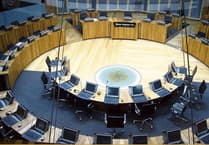From September 2023, a new default 20mph speed limit applies to residential and busy pedestrian streets with streetlights in Wales.
The Welsh Government is making this change for a number of reasons, including:
- reducing the number of collisions and severe injuries from them (also reducing the impact on the NHS from treating the people who are injured)
- encouraging more people to walk and cycle in our communities.
- helping to improve our health and wellbeing.
- making our streets safer; and
- safeguarding the environment for future generations.
According to the World Health Organisation, the most effective way to improve pedestrian safety is to reduce the speed of vehicles. The evidence from around the world is very clear – reducing speed limits reduces collisions and saves lives. In the distance it takes for a car travelling 20mph to stop, a 30mph car is still moving at 24mph. This makes a substantial difference to the ability to avoid collisions. When a pedestrian is hit by a vehicle travelling at around 30mph they are around five times more likely to be killed than when hit by a vehicle travelling around 20mph.
Public Health Wales believes that lowering the default speed limit to 20mph could have substantial health benefits. 20mph will reduce the risk of collisions, help people feel safer and benefit people’s physical and mental well-being. A recent public health study estimated that the 20mph default speed limit could result in:
- 40% fewer collisions.
- saving 6 to 10 lives every year.
- and avoiding 1200 to 2000 people being injured every year.
This would save around £92m in prevention during the first year alone.
There is also evidence from across the world that vehicle speeds are one of the main reasons why people do not walk or cycle or do not allow their children to walk or cycle to school. Lower traffic speeds will create more liveable communities and encourage walking and cycling. People will feel more comfortable when walking and cycling. It will be safer for children from the moment they are outside their homes, playing or walking to school, while older people will also feel more able to travel independently and safely.
Driving slower produces less noise, reduces fuel consumption, and exhaust and non-exhaust emissions are also likely to be reduced. Accelerating up to a reduced speed of 20mph, and driving at a more consistent speed, should result in lower tyre, and brake abrasion and this can also save on your fuel costs.
The Welsh Government is working closely with GoSafe and the Police, who enforce speed limits in Wales, to ensure that the new speed limits are respected, and driver behaviour change is supported.
Whilst 20mph will become the default for residential and busy pedestrian streets, not all roads will change to 20mph. Local Councils will consider which streets should remain at a 30mph limit. Streets that will have a 30mph limit will also have 30mph repeater signs installed. This means that where there is street lighting on a road, with no speed limit signs, drivers should always assume that the speed limit is 20mph.
In the latest public opinion survey, published in September 2022, almost two thirds of people were in support of a lower speed limit where they live, 62% agreed they ‘wished everyone would slow down a bit on the roads’ and 55% agreed that ‘streets would be a lot nicer for pedestrians with a 20mph speed limit’.
Other feedback, from correspondence received by the Welsh Government, has been that people who live on streets that have a 20mph limit quickly get used to the slower traffic speed and see the benefit of it.
The 20mph default limit will be in place where people live. It is being implemented for the benefit of residents and their communities. Its introduction will make for safer streets and healthier communities.
Welsh Government spokesperson said:
“The new legislation will not apply a blanket speed limit on all roads, it will simply make the default limit 20mph. Ultimately, it will be down to Local Authorities to decide which roads should retain the 30mph limit in consultation with their residents. Together, we are drawing lessons from first phase settlements.”




